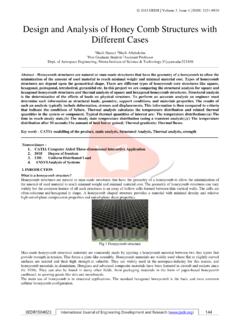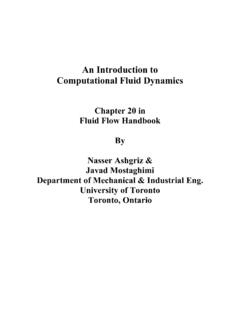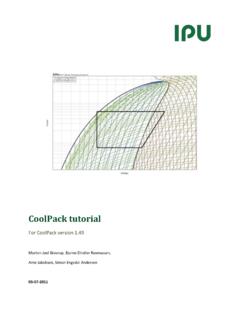Transcription of Intro to Transient Thermal Analysis
1 DECEMBER 2019. Intro to Transient Thermal Analysis Thermal Capacitance in heat transfer Analysis . Lesson 1. Introduction How long does it take for a cup of coffee to cool down to room temperature? How much time do you have to shape melted glass? Transient Analysis can help determine the answers to such questions. Transient Thermal analyses determine temperatures and other Thermal quantities that vary over time. Many heat transfer applications involve Transient Thermal analyses such as: heat treatment problems Electronic package design Nozzles Engine blocks Pressure vessels 2. Thermodynamics of Energy Conservation Power output from system Power input to the system = +.
2 Rate of energy storage inside the volume . 3. Governing Equation The governing equation for the heat conduction through a solid is given by: 2 2 2 . 2. + 2 + 2 + = .. Or where, = Thermal conductivity (in ). 2 + = = Time . = Temperature ( in ). = Rate of heat flux/convection/. radiation/internal heat generation inside the Rate of heat Rate of volume (in ). conduction energy storage inside = Density of the material (in 3 ). Rate of heat flux/convection/ the volume radiation/internal heat generation = Specific heat of the material (in ). inside the volume 4. Governing Equation (cont.). In the equation for Transient heat conduction, the term on the right is the rate of energy storage in the body.
3 We will call this the Transient term. This differentiates Transient Analysis from the steady-state, where temperature distribution does not change with time. For a long period of time, when the temperature distribution does not change any more, we say the problem has reached a steady-state condition that is governed by Fourier's law. For example, in the graph below the temperature profile stabilizes after 50 seconds. 2 2 2 . + + + = Transient Term 2 2 2 . Temperature ( ). 140. 120. 100. 80. 60. 40. 20. 0. 0 10 20 30 40 50 60 70. Time(s). 5. A Note About Initial Temperatures A Transient Thermal Analysis involves loads that are functions of time.
4 The first step in applying Transient Thermal loads is to establish the initial temperature distribution at time = 0. Initial temperatures do not matter in steady-state analyses. Initial temperatures are very important in Transient analyses. For example, when leaving ice water and hot tea in the sun for 5 mins, the final temperatures will be different. Ice water Hot tea 6. Thermal Capacitance and the Thermal Capacitance Term The product of density ( ), specific heat (c) and volume (V) for a body is the Thermal capacitance (C). We can call the product the Thermal capacitance term, which indicates the ability of the body to store Thermal energy.
5 The larger the Thermal capacitance term, the more time it will take to heat the body and vice-versa. 2 2 2 . 2. + 2 + 2 + = .. Thermal capacitance term In matrix form the Transient Thermal heat conduction can be written as: C{ } + { } = Q(t). Thermal Capacitance Thermal heat Rate Matrix Conductivity Matrix Vector 7. Structural Analogy A body with larger Thermal capacitance will take more time to heat compared to a body having smaller capacitance. This is analogous to the inertia of a structure seen in structural Analysis . A body with large mass offers large resistance (inertia) to motion compared to a body of smaller mass. Because of this analogy Thermal capacitance is also called Thermal mass.
6 Thermal Capacitance Structural Inertia C{ } + { } = Q(t) M { } + + { } = F(t). heat Storage heat Applied Inertia Damping Stiffness Applied Conduction Transient heat Transient Force Flow 8. Electrical Analogy The inverse of Thermal conductivity is Thermal resistance, which is analogous to electric resistance. Similarly, in a Transient Analysis Thermal capacitance is analogous to electrical capacitance, which is related to storage of electric charge. Ta R Ta C heat in = q C R. q heat out + heat stored Te Te An insulated enclosure surrounded by wall where: An electric circuit where: R = Thermal resistance of the walls R = Electrical resistance, dissipates energy C = Thermal capacitance of the enclosure the heat C = Capacitance of the capacitor, stores energy q = heat flow rate into the enclosure q = Current flow through the source Te = Temperature of the enclosure Te = Temperature of one end of the capacitor Ta = Constant ambient temperature Ta = Temperature at the other end of the capacitor 9.





